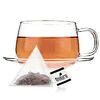The Tea Horse Road
茶马道 (Cha Ma Dao, Tea Horse Road); a rich part of not only China’s history, but the past and history of tea itself. Let’s follow tea to its roots and take a peek into the Tea Horse Road and learn a little about its rich historical significance!
What Is It?
Starting around a thousand years ago, the Tea Horse Road was a trade link from Yunnan to Tibet; and to Central China through Sichuan Province. The complete length of the Sichuan–Tibet road was over 4,000 kilometers, and it has a history of 1,300 years.
This route was a network of caravan paths winding through the high elevation mountains of Yunnan, Sichuan, and Guizhou in the Southwest of China. From the 6th century to the 20th century, people in Sichuan and Yunnan provinces physically carrying packs of tea traveled by foot and horseback with pack horses for the traditional 'tea-for-horse' trade between Han and Tibetan people. It spans the two highest plateaus of China (Qinghai, Tibet and Guizhou, Yunnan) before finally reaching the Himalayas.
What’s In A Name?
The route earned the name “Tea Horse Road” 茶马道 (Cha Ma Dao) because of the common trade of Tibetan ponies for tea, a practice dating back at least to the Song dynasty, when the short-legged sturdy horses were important for China to fight warring nomads in the north.
Protection and Recognition
South West China is incredibly culturally diverse, and there are more than twenty different ethnic minority groups to be found along the Tea Horse Road route. Many famous villages that were once key stations and markets of the Tea Horse Road are now listed among the most important international sites for historic cultural preservation. For example, the Lijiang, where the Naxi people form the majority of inhabitants, was been designated as a world cultural heritage site by UNESCO in 1997. In 2002, Sidengjie village, Shaxi Township in Yunnan, was listed as a “protected world architectural heritage site” by the World Architecture Foundation.
Cultural Importance
Though the Tea Horse Road is not nearly as important as the Silk Road of China, it holds significance nonetheless.
Yunnan tea has been of vital economic importance to many nationalities since the Tea Horse Road, to even today: the Deang, Bulang, Hani, and Wa people groups all benefit from tea production. There are many myths and legends that stress the importance of Pu’erh tea to these peoples even today!
Today
The winding paths are overgrown, well-worn, covered and no longer in use; (except for some incredible dedicated hikers and explorers), but the significance and importance of the Tea Horse Road still deserves the awe and attention of tea enthusiasts today.
Many Yunnan teas are still grown around the key stations and the southernmost part of the Ancient Tea Horse Road, including our new delicious 20 Year Aged Iceland Pu’erh Raw, among others. Even today, you can experience a rich taste of history- one sip at a time.








































